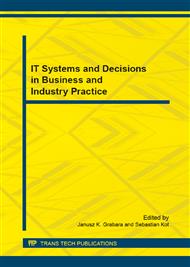[1]
D.W. Brooks, Web-Teaching: A Guide to Designing Interactive Teaching for the World Wide Web (Innovations in Science Education and Technology) Paperback April 30, (1997).
Google Scholar
[2]
W. Cellary, Techniki Internetowe (Internet Techniques), Wydawnictwo Akademii Ekonomicznej(The Publishing House of Poznan Academy of Economics), Poznań (2005).
Google Scholar
[3]
W. Cellary, Wykład: Społeczeństwo informacyjne (Lecture: Information Society), Poznań, (2012).
Google Scholar
[4]
M. Jasiulewicz-Kaczmarek, The role of ergonomics in implementation of the social aspect of sustainability, illustrated with the example of maintenance, [in: ] Arezes, P, Baptista, JS, Barroso M, et al. (Eds. ) Occupational Safety and Hygiene. CRC Press, Taylor & Francis: London, pp.47-52, London (2013).
DOI: 10.1201/b14391-11
Google Scholar
[5]
B.A. Galwas, Współczesne systemy kształcenia ustawicznego na odległość (Contemporary Systems of Distance Lifelong Learning), Wydział Elektroniki i Technik Informacyjnych Politechniki Warszawskiej (The Department of Electronics and Information Technology at the Warsaw University of Technology), Warszawa, (2000).
Google Scholar
[6]
B.A. Galwas (Ed. ), Edukacja w Internecie (Education in the Internet). Ośrodek Kształcenia na Odległość Politechniki Warszawskiej (The Department of Distance Learning at the Warsaw University of Technology), Warszawa, (2001).
Google Scholar
[7]
B.A. Galwas (Ed. ): Edukacja w przyszłości i przyszłość w edukacji (Education in the Future and Future in the Education). Ośrodek Kształcenia na Odległość Politechniki Warszawskiej (The Department of Distance Learning at the Warsaw University of Technology), Warszawa, (2001).
Google Scholar
[8]
Rozporządzenie Ministra Nauki i Szkolnictwa Wyższego z dnia 25 września 2007 r. w sprawie warunków, jakie muszą być spełnione, aby zajęcia dydaktyczne na studiach mogły być prowadzone z wykorzystaniem metod i technik kształcenia na odległość (Regulation of the Ministry of Science and High Education from the 25th of September, 2007, concerning the conditions which must be met to apply distance learning at universities) (Dz.U. 2007 nr 188 poz. 1347).
Google Scholar
[9]
G. Fenstermacher, F. Soltis, Style nauczania (Styles of Teaching), Wydawnictwa Szkolne i Pedagogiczne, Warszawa, (2000).
Google Scholar
[10]
Konferencja Moc Mooców" Fundacja Młodej Nauki - 20 stycznia 2015 (Conference "Moc Mooców, by Foundation of Young Science).
Google Scholar
[11]
M. Szafrański (Ed. ), Wielkopolski system monitorowania i prognozowania w zakresie kształcenia zawodowego (Wielkopolska Monitoring and Forecasting Systems of Vocational Training), Wydawnictwo Politechniki Poznańskiej, Poznań (The Publishing House of Poznań University of Technology), (2011).
Google Scholar
[12]
K. Sacha, Inżynieria oprogramowania (Engineering of software), Wydawnictwo Naukowe PWN SA (Science Publishing House PWN SA), Warszawa, (2010).
DOI: 10.18778/0867-5856.20.2.06
Google Scholar
[13]
M. Kąkolewicz, Technologie informacyjne a konieczność zmiany paradygmatów edukacji (Information Technologies and the Necessity to Change Paradigms in Educations), [in] Koncepcje i praktyka e-edukacji (Concepts and Practice of E-learing), M. Dąbrowski i M. Zając (Eds. ) , Wyd. Fundacji Promocji i Akredytacji Kierunków Ekonomicznych (The Publishing House of Promotion and Economics Accreditation Foundation), Warszawa, (2011).
Google Scholar
[14]
A.K. Stanisławska-Mischke, information on: http: /www. cel. uek. krakow. pl/moodle/file. php/1/zalety_i_wady_wykorzystania_nowych_technologii. pdf.
Google Scholar
[15]
M. Eisenstadt, T. Vincent, The knowledge web: Learning and collaborating on the Net, UK: Kogan Page, (2000).
Google Scholar
[16]
A. Ravenscroft, Designing E-learningInteractions In the 21st Century: revisiting and rethinking the role of theory. European Journal of Education, 36(2), 133-156, (2001).
DOI: 10.1111/1467-3435.00056
Google Scholar


